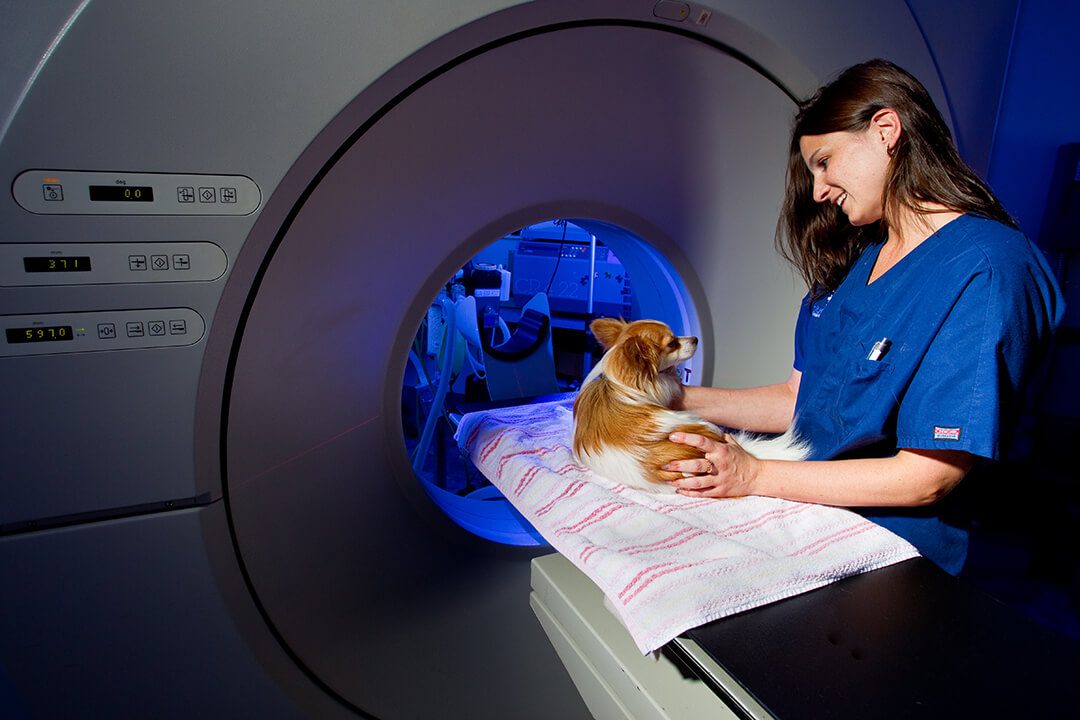Fighting canine cancer with veterinary oncology.
Just like their humans, dogs are also at risk for developing different types of cancer, including lymphoma and even breast cancer. The good news is, the same treatments used to treat cancer in humans are also available for pets with veterinary oncology.
While this is not a definitive list, here are some of the different types of cancer that can affect dogs.
Types of cancer in dogs.
Anal sac cancer.
Anal Sac Cancer affects the scent glands located along each side of a dog’s anus. The primary role of these glands is marking territory, as they secrete small amounts of a foul-smelling substance during bowel movements.
Anal sac cancer is usually malignant with a high tendency to spread to other parts of the body. Both male and female dogs can develop anal sac cancer, with the average age falling around 10 years. Breeds known to be at risk for this form of cancer include the Spaniel breeds; however, it can affect any breed.
Bladder cancer.
There are a few different types of tumors that can cause bladder cancer in dogs. The most common, transitional cell carcinoma (TCC), develops in the deeper layers and muscles of the bladder wall. As the tumor grows, it may invade the urethra and obstruct urine flow, causing difficulty urinating or total blockage. This can result in a serious pet emergency requiring immediate attention.
Bladder cancer is more common in middle-aged and elderly female dogs, and can occur in any breed. However, breeds most commonly affected include Shetland sheepdog, Scottish terrier, wirehair fox terrier, West Highland terrier and beagle.
Hemangiosarcoma.
Hemangiosarcoma is a cancer that develops from blood vessels, with tumors typically developing in the spleen, liver, skin or heart. However, this form of cancer can grow anywhere in the body and usually affects middle-aged and older dogs.
Hemangiosarcoma can affect any breed, however, it’s most commonly found in German shepherds and both golden and Labrador retrievers. Males also appear to be predisposed to this type of cancer.
Liver cancer.
Liver cancer can be a silent killer in dogs because obvious clinical signs are not always apparent. This type of cancer is caused by several different types of malignant tumors, however, it usually involves a single, large tumor called a hepatocellular carcinoma. This tumor is localized in the liver and does not commonly spread to other parts of the body.
Liver cancer can affect any breed and usually affects older dogs, although it has been known to occur in younger dogs.
Lymphoma.
One of the most commonly diagnosed cancers in dogs, lymphoma is cancer of the lymph nodes and lymphatic system. In dogs, lymphoma can affect many different organs of the body, but is most commonly found in the peripheral lymph nodes, which are located deep within subcutaneous tissue (the innermost layer of the skin).
This form of cancer affects dogs of any age and breed, however, it’s most commonly found in golden retrievers and dogs between the ages of 6 and 9.
Breast cancer.
Just like in humans, breast cancer involves tumors of the mammary glands. In dogs, there are 10 mammary glands that extend from the chest to the abdominal wall in rows of two. Tumors can develop in any of these glands, however, they’re more commonly found in the two sets closest to the hind legs.
Older female dogs are at higher risk of developing mammary tumors, particularly those that are unspayed or were spayed after 2 years of age. Breeds known to be at higher risk of developing mammary tumors include poodles, terriers, English spaniels and English setters.
Mast cell tumors.
A mast cell tumor (MCT) is a type of cancer that is made up of normally healthy cells that have grouped together and formed a mass. These tumors most commonly form on the skin but can also affect other parts of the body. Including the respiratory and digestive tracts. In dogs, MCTs may be relatively benign and easily treatable with surgery. However, they can also be much more aggressive and spread to other parts of the body.
Although mass cell tumors can develop in dogs of any age, they are more common in older dogs, with boxers, bull terriers, Boston terriers and Labrador retrievers being the more susceptible breeds.
Melanoma.
A common form of skin cancer in dogs, melanoma involves tumors that originate from melanocytes, which are the skin cells responsible for producing pigment in nails, skin and eyes. Although most commonly found as masses or lumps on the skin, these tumors have a high tendency of spreading and can affect different parts of the body. They also have a tendency to bleed as they continue growing.
Melanoma can affect dogs of any breed but is more commonly seen in chow chows, cocker spaniels, poodles and schnauzers.
Oral melanoma.
Oral melanoma involves tumors that affect the oral cavity and is the most common type of oral tumor in dogs. This form of cancer can develop along the gums, lips and other parts of the mouth. The tumors may be benign or malignant and usually continue to grow, causing discomfort and difficulty eating.
Oral melanoma commonly occurs in older dogs with darker areas of pigmentation in the mouth. Breeds at higher risk include boxer, chow chow, cocker spaniel, German shepherd, German shorthaired pointer, golden retriever, Gordon setter, miniature poodle and Weimaraner.
Stomach cancer.
Stomach cancer is not one of the most common types of canine cancer, but it can be one of the most devastating. This type of cancer generally shows no symptoms until it has already progressed to advanced stages. Several different types of tumors are associated with stomach cancer in dogs, most of which are malignant and may spread to other parts of the body.
This type of canine cancer is most commonly found in older male dogs. Breeds known to be predisposed to this type of cancer include the rough collie, Staffordshire bull terrier, Belgian shepherd dog and chow chow.
Soft tissue sarcoma.
Soft tissue sarcoma is a common type of cancer found in dogs that consists of a variety of malignant tumors that affect the connective tissues of the body, such as fat muscles and cartilage. They usually appear in the form of non-painful lumps and can occur anywhere on the body, but most commonly develop on the limbs, chest or abdominal wall.
Soft tissue sarcoma can affect dogs of any age and breed, but is most commonly diagnosed in older, large-breed dogs, with golden retrievers, Saint Bernards and Doberman pinschers known to be at higher risk.
Testicular cancer.
Testicular cancer affects male dogs and involves tumors that form on the testicles. Testicular tumors most commonly affect intact (unneutered) dogs over the age of 10. However, they can affect intact dogs of any age, particularly those with undescended testicles, a condition known as cryptorchidism.
Breeds known to be predisposed to the condition include Afghan hounds, boxers, collies, German shepherds, Maltese, Shetland sheepdogs and Weimaraners.
Thyroid cancer.
Thyroid cancer involves tumors that affect the thyroid, a gland in the neck responsible for releasing important hormones that regulate metabolism and help control major functions of the body. Thyroid tumors are almost always malignant and often spread to the lungs and lymph nodes They can also invade nearby structures such as the windpipe, blood vessels and esophagus.
Fortunately, thyroid cancer is relatively uncommon in dogs, however, beagles, boxers and golden retrievers between the ages of 9 and 11 are known to be at higher risk.
Recognizing the warning signs of cancer in dogs.
Early detection is key to treating cancer, so knowing how to recognize the warning signs of cancer in pets is an important first step.


